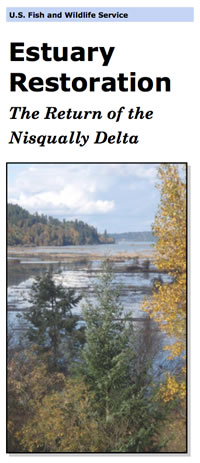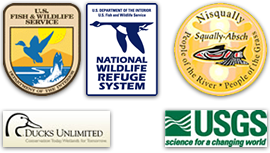References
Documents listed here are in PDF format (requires Adobe Reader) unless otherwise specified.
Nisqually Newsletter
The Flyway, Quarterly newsletter of Nisqually and Grays Harbor National Wildlife Refuges:
- Summer 2011 [1.7 MB PDF]
- Spring 2010 [2.3 MB PDF]
- Fall 2010 [3 MB PDF]
Nisqually Information
- Barham, J. 2010. Nisqually National Wildlife Refuge: estuary restoration. Spotlight on Science, October 2010. Oral Presentation. Portland, Oregon. [Links to Media]
- Burg, M.E., D.R. Tripp, and E.S. Rosenburg. 1980. Plant Associations and Primary Productivity of the Nisqually Salt Marsh on Southern Puget Sound, Washington. Northwest Science 54: 222-236.
- Ellings, C., K. Turner, E. Grossman, K. Larsen, J. Cutler, S. Rubin, I. Woo, A. Lind-Null, C. Curran, F. Leischner, S. Hodgson, and A. David. 2010. Expanding research to keep pace with extensive restoration in the Nisqually Delta. The 2010 South Sound Science Symposium. Poster Presentation. Shelton, Washington. [10.3 MB]
- Ellings, C.S., and S. Hodgson. 2007. Nisqually river estuary baseline fish ecology study: 2003-2006. Nisqually National Wildlife Refuge and Nisqually Indian Tribe, Olympia, Washington.
- Ellings, C.S. 2008. Draft Nisqually National Wildlife Refuge estuary restoration project monitoring framework. Unpublished report to Nisqually National Wildlife Refuge. 21p.
- Jones, J.L., T.L. Haluska, and D.L. Kresch. 2001. Updating Flood Maps Efficiently Using Existing Hydrolic Models, Very-High-Accuracy Elevation Data, and a Geographic Information System, a Pilot Study on the Nisqually River, Washington. USGS Water-Resources Investigations Report 01-4051. 36p.
- Karlstrom, E.L. 1971. Notes on the Marine Biology of the Nisqually, the Outer Flats, Delta Front, and Reach.
- Lind-Null, Angela, Larsen, Kimberly, Reisenbichler, Reginald, 2008, Pre-Restoration habitat use by Chinook Salmon in the Nisqually Estuary using otolith analysis: U.S. Geological Survey Open File Report 2008-1021, 13 p.
- Lind-Null, Angie, and Larsen, Kim 2010. Otolith analysis of pre-restoration habitat use by Chinook salmon in the delta-flats and nearshore regions of the Nisqually River Estuary, U.S. Geological Survey Open-File Report 2010-1238, 28p.
- Lind-Null, Angie, Larsen, Kim, Reisenbichler, Reg, 2008, Characterization of estuary use by Nisqually Hatchery Chinook based on otolith analysis: U.S. Geological Survey Open File Report 2008-1102, 12 p.
- Lind-Null, Angie, Larsen, Kim, 2009, Pre-Restoration habitat use by Chinook Salmon in the Nisqually Estuary using otolith analysis: An additional year: U.S. Geological Survey Open File Report 2009-1106, 18 p.
- Mason, S., E. Ratajak, J. Schuett, and P. Searles. Vegetation of the Nisqually Delta. 28p.
- Minnella, H. and K.L.Turner. 2010. Nisqually National Wildlife Refuge restoration monitoring preliminary data. University of Washington-Tacoma Environmental Research Symposium. Poster Presentation. Tacoma, Washington. [4.2 MB]
- Naglich, F.G. 1994. Reed Canarygrass in the Pacific Northwest: Growth Parameters, Economic Uses, and Control.
- Nisqually NWR. November 2010. Restoration Brochure: Estuary Restoration, The Return of the Nisqually Delta.
- Turner, K., I. Woo, J. Takekeawa, C. Ellings, F. Leischner, E. Grossman, J. Barham, and J. Takekawa. 2010. Restoring the Nisqually Delta: a coordinated science approach for adaptive management. Coastal and Estuarine Research Federation 20th Biennial Conference. Oral Presentation. Portland, Oregon. (abstract)
- Turner, K., J.Y. Takekawa, and I. Woo. 2010. Nisqually estuary restoration: monitoring the response. Spotlight on Science, October 2010. Oral Presentation. Portland, Oregon. [Links to Media]
- US Fish and Wildlife Service. 2005. Nisqually National Wildlife Refuge Final Comprehensive Conservation Plan. 304p.
- US Fish and Wildlife Service. 2005. Nisqually National Wildlife Refuge Final Comprehensive Conservation Plan. 304p.
- Woo, I., and J. Y. Takekawa. 2008. Restoration of the Nisqually estuary: monitoring initial progress of the Nisqually National Wildlife Refuge tidal restoration. USGS proposal to the FWS Nisqually National Wildlife Refuges. Vallejo, California. 11pp.
- Woo, I., K. L. Turner, and J. Y. Takekawa. 2010. Pre-restoration vegetation summary in the Nisqually Delta, Fall 2009. Unpublished data summary update. USGS, Western Ecological Research Center, San Francisco Bay Estuary Field Station, Vallejo, CA.
Puget Sound Information
- Barnhardt, W.A. and B.L. Sherrod. 2006. Evolution of a Holocene delta driven by episodic sediment delivery and coseismic deformation, Puget Sound, Washington, USA. Sedimentology 1–18.
- Beamer, EM & K Larsen. 2004. The importance of Skagit delta habitat on the growth of the wild ocean-type Chinook in Skagit Bay: Implications for delta restoration.
- Beamer, EM, A McBride, C Greene, R Henderson, et al. 2005. Delta and nearshore restoration for the recovery of wild Skagit River Chinook salmon: Linking estuary restoration to wild Chinook salmon populations.
- Beamer, EM, JC Sartori, KA Larsen. 2000. Skagit Chinook life history study progress report number 3.
- Collins, B.D. and D.R. Montgomery. 2002. Forest development, wood jams, and restoration of floodplain rivers in the Puget Lowland, Washington. Restoration Ecology 10: 237-247.
- Duffy, EJ, DA Beauchamp, RM Sweeting, RJ Beamish, JS Brennan. 2010. Ontogenetic Diet Shifts of Juvenile Chinook Salmon in Nearshore and Offshore Habitats of Puget Sound. Transactions of the American Fisheries Society 139:803–823.
- Hood, W.G. 2006. A conceptual model of depositional, rather than erosional, tidal channel development in the rapidly prograding Skagit River Delta (Washington, USA). Earth Surface Processes and Landforms 31: 1824-1838.
- Hood, W.G. 2007. Large woody debris influences vegetation zonation in an oligohaline tidal marsh. Estuaries and Coasts 30: 441-450.
- Hood, W.G. 2007. Scaling tidal channel geometry with marsh island area: a tool for habitat restoration, linked to channel formation process. Water Resources Research 43.
- Hood, W.G. Sweetgale, Beaver, Salmon, and Large Woody Debris in the Skagit River Tidal Marshes [HTML]
- Hood, W.G. 2004. Indirect environmental effects of dikes on estuarine tidal channels: thinking outside of the dike for habitat restoration and monitoring. Estuaries and Coasts 27: 273-282.
- Puget Sound Nearshore Partnership Publications
- Sherrod, B.L. 2001. Evidence for earthquake-induced subsidence about 1100 yr ago in coastal marshes of southern Puget Sound, Washington. Geological Society of America Bulletin 10: 1299-1311.
- Thom, R.M., and L. Hallum. 1991. Long-Term Chnages in the Areal Extent of Tidal Marshes, Eelgrass Meadows and Kelp Forests of Puget Sound.
Other Information
- Takekawa, J.Y., A.K. Miles, D.H. Schoellhammer, B. Jaffe, N.D. Athearn, S.E. Spring, G.G. Shellenbarger, M.K. Saiki, F. Mejia. 2005. South bay salt ponds restoration project short-term data needs, 2003-2005. Unpublished Draft Final Report, U.S. Geological Survey, Vallejo, CA 267p.
- Tsukada, M. and S. Sugita. 1982. Late Quaternary dynamics of pollen influx at Mineral Lake, Washington. Bot. Mag. Tokyo 95: 401-418.
- Walters, D.M., A.H. Roy, and D.S. Leigh. 2009. Ecological Indicators of macroinvertebrate and fish assemblage integrity in
urbanizing watersheds. Ecological Indicators in press. - Woo, I., J. Y. Takekawa, A. Rowan, L. Dembosz, and R. Gardiner. 2008. The Benicia-Martinez (BenMar) Restoration Project: 2007 Annual Report, U. S. GeologicalSurvey, Western Ecological Research Center, San Francisco Bay Estuary Field Station, Vallejo, CA. 44p.

![The Flyway, Summer 2011 [1.7 MB PDF] The Flyway, Summer 2011 [1.7 MB PDF]](images/flyway-summer-2011.jpg)
![The Flyway, Fall 2010 [3 MB PDF] The Flyway, Fall 2010 [3 MB PDF]](images/FlywayFall2010e-200w.jpg)
![The Flyway, Spring 2010 [2.3 MB PDF] The Flyway, Spring 2010 [2.3 MB PDF]](images/Flyway_spr2010_fin-200w.jpg)
